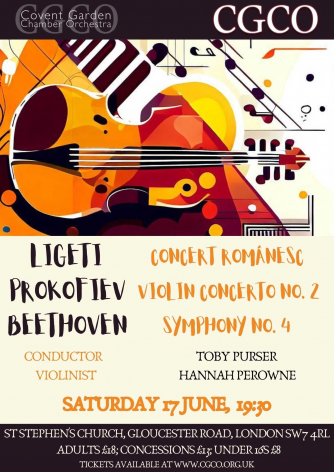Details
St Stephen's Church
Southwell Gardens
Kensington
London
SW7 4RL
England
Programme
György Ligeti – Concert Romanesc
Sergey Prokofiev – Violin Concerto no.2, Op.63
~ Interval ~
Ludwig van Beethoven – Symphony no.4 in B flat major, Op.60
Performers
Toby Purser – Conductor
Hannah Perowne – violin
Covent Garden Chamber Orchestra
Programme Note
To round off our 2022-2023 season we have a very special line-up of pieces conducted by Toby Purser, the newly-appointed head of conducting at the Royal College of Music featuring renowned violinist Hannah Perowne.
LIGETI CONCERT ROMÂNESC
Ligeti's 1951 Concert Românesc is based in part on actual Romanian folk music Ligeti had studied at the Folklore Institute of Bucharest in 1949, in part on his own folk-like invention "in the spirit of the village bands." Like his compatriots Bartók and Kodály before him, Ligeti had a genuine interest in folk music. As a child in the border region of Transylvania (then in Hungary, now in Romania), he had encountered local musicians wearing animal masks and playing wild music on violin and bagpipes, a memory that remained vivid even many years later.
Yet his Concerto's modestly modern touches, which seem wholly unobjectionable today, were enough to cause trouble: it was banned after a single rehearsal in Budapest, and it did not receive a public performance until 1971. The Concerto's four short movements follow one another without pause. Of particular interest is the slow third movement, in which (perhaps echoing another childhood memory, of alpine horns heard in the Carpathian mountains) Ligeti instructs the horns to use natural tuning, without valves, an idea that was to return strongly in his music of the 1980s and 1990s, such as the Horn Trio and the Hamburg Concerto.
The finale ventures nearer to Bartók, both to his fast, Romanian-inspired dance finales (such as that of the Concerto for Orchestra) and to his garish modernist ballet, The Miraculous Mandarin.
PROKOFIEV VIOLIN CONCERTO NO. 2
The Second Violin Concerto was Prokofiev's last Western commission before returning to Russia, from the French violinist Robert Soëtens, who had played the 1932 premiere of Prokofiev's Sonata for Two Violins with Samuel Dushkin.
The soloist opens the concerto, alone and unequivocally in G minor. Yet by the end of his metrically ambiguous phrase, the muted violas and basses enter in the remote key of B minor. The home key is soon restored, however, and the warm second theme enters in the relative major, B-flat. In the recapitulation, it is the cellos and basses that bring back the opening theme. When they get to the point where the orchestra had redirected the motion to B minor, it is the soloist who now enters in G minor, completing a classical harmonic reconciliation.
The Andante assai is in many ways the sunlight version of the dark lyricism of the first movement. The soloist arcs a radiant, long-breathed melody over pizzicato strings, their two-against-three metrical divergence suggesting a gentle jazz rubato more than real tension. This is launched in E-flat major, and at the close of the soloist's initial statement, strings take it up, muted and on B as in the first movement, though this time in major mode.
Prokofiev's rondo finale is dance music, angular and athletic. The premiere performance was scheduled for Madrid, and Prokofiev added castanets and Spanish ornamentation and cross-accents to the mix. It ends with a big coda, mostly with the soloist dancing furiously in 5/4 with just percussion and a bass line - the final flurry is marked tumultuoso.
BEETHOVEN SYMPHONY NO. 4
The symphony opens with a dark and brooding slow introduction which unfolds almost entirely in the minor, as though the music were groping its way towards the light. No less original is the way in which, in the following Allegro, the recapitulation is approached. This is the crucial moment where the main theme returns in the home key, and Beethoven highlights it by creating an atmosphere of hushed expectancy, before a sudden outburst announces the arrival of the recapitulation itself.
The slow movement is largely based on one of Beethoven’s favourite oppositions: a smoothly sustained melody unfolding over an accompaniment in a sharply defined, military-style rhythm. The rhythm pauses for the theme’s luxuriant continuation, but it returns in the closing bars of the piece, where the spotlight again falls on the timpani, which give it out on their own.
The bubbling finale is a piece imbued with the spirit of Haydn, and in its closing bars he allows the music to degenerate into farce: fragments of the main theme are limply played at half speed, as though the piece were about to collapse altogether, before an abrupt gesture from the full orchestra brings the curtain down.

 Your events at Classical Events
Your events at Classical Events

